Preliminary Tests on the Sensitivity of the FORAIR_IT Air Quality Forecasting System to Different Meteorological Drivers
Abstract
1. Introduction
2. Materials and Methods
2.1. FORAIR_IT Current Setup
2.2. WRF as Alternative Meteorological Driver
- Single-Moment 6 class scheme (WSM6) for microphysics;
- Rapid Radiative Transfer Model (RRTMG) for short- and long-wave radiation;
- MM5 (Fifth Generation NCAR/Penn State Mesoscale Model) scheme for surface layer;
- Noah Land Surface Model for land surface;
- Yonsei University scheme for Planetary Boundary Layer;
- Kain–Fritsch scheme for cumulus parameterization at 20 km resolution (turned off at 4 km resolution).
2.3. FORAIR_IT Evaluation
2.3.1. Weather Conditions during the Selected Periods
2.3.2. Evaluation of Forecast Concentrations
- Root Mean Square Error (RMSE), referring to hourly concentrations throughout the day and to the daily maximum of hourly concentrations. The value, expressed in µg/m3, is higher than or equal to zero by definition and the target value is zero (the lower the RMSE, the better the model performs);
- Correlation Coefficient (R), referring to hourly concentrations throughout the day. The non-dimensional value is between −1 and one by definition and the target value is one (the higher the R, the better the model performs);
- Modified Mean Bias (MMB), referring to hourly concentrations throughout the day. The non-dimensional value is between −2 and two and the target value is zero (the lower the absolute value of MMB, the better the model performs). Values lower than zero mean model underestimation, values higher than zero mean model overestimation. This indicator is often preferred to bias alone in evaluating model-based pollutant concentrations, because atmospheric species can vary greatly over time, space and evaluation metrics; therefore, a relative indicator ensures comparability between the performance of different species, and because it is symmetric, it therefore represents both underestimations and overestimations [83].
2.4. WRF and RAMS Configuration Tests
3. Results and Discussion
- RMSE, R and MMB, synthesizing all valid monitoring stations and all the hours of the whole month;
- RMSE of the daily maximum of hourly concentrations, synthesizing all valid monitoring stations for each day of the month, and RMSE of hourly concentrations, synthesizing all valid monitoring stations and all days of the month for each hour of the daily cycle;
- R and MMB of hourly concentrations, synthesizing all valid monitoring stations and all days of the month for each hour of the daily cycle;
- Maps of the monthly average field of model concentrations, overlaid by monthly model skills on single monitoring stations.
3.1. NO2
3.2. O3
4. Conclusions
- WRF significantly improves RAMS-driven results on R, indicating its higher capability in reproducing the spatial and temporal variability of concentrations. This is the first confirmation of the potential for improvement by using WRF in FORAIR_IT;
- The results of the Base WRF-driven simulation compared to the observed values show that the model performs better in January with respect to August for NO2, while the opposite is true for O3. The daily cycle of average hourly concentrations of NO2 in January is underestimated in daytime and well reproduced during night time, and it is generally well reproduced in August. The daily cycle of O3 is generally overestimated in both months. Daily maxima concentrations of both pollutants are quite well reproduced in January, apart from some underestimation of NO2 in the first half of the month, and overestimation in August. The picture (underestimation of NO2, overestimation of O3) seems to confirm a common finding in regional-scale CTM simulations, with several explanations (underestimation of road traffic emissions, lack of spatial resolution);
- Monthly scores showed that a general improvement is obtained by directly using the Heat Flux and Wind Stress (HF+U*) and the Mixing Height (Hmix) estimated by WRF, for both the analysed pollutants. The All configuration shows the best performance out of the other configurations, with several improvements on O3. HF+U* is improved by physics in WRF (MM5 surface layer scheme for U* and Noah land surface model for HF), while Hmix gives a larger improvement to O3, likely due to the better representation of PBL vertical mixing in WRF. RAMS has significantly lower correlations, indicating an inferior capability in reproducing the spatial variability in monthly concentrations, and lower MMB on O3, probably due to more accurate solar radiation enhancing the photochemical generation of the pollutant;
- Concerning the time variability of the statistical scores, in terms of both intra-day variability and daily cycle variability, all the experiments show similar features, suggesting that the introduction of new meteorological variables into the CTM do not significantly change the time variability of the concentrations for both pollutants and months. For NO2, both in January and in August, HF+U* and Hmix score the best results in most (but not all) hours of the day. For O3, both in January and in August, all configurations show better performances in daytime (apart early morning in August), with Hmix and HF+U* presenting the best overall results. As with the monthly scores, the All configuration shows the best performance out of the two mentioned configurations and shows further improvements in August night time hours, probably due to better PBL stability. RAMS has, again, significantly lower correlations and hence worse skills in following the variability; however, it has lower O3 MMB values, namely in January night time (due to better PBL stability) and all hours during a typical August day (confirming the better solar radiation and indicating that this will be a key parameter to be taken from WRF and tested in future analyses);
- The spatial distribution of performance skill scores (MMB and R) calculated at monitoring stations for the Base configuration did not show a clear variability with the location. For NO2 in August, both MMB and R are slightly higher in urban areas of the Po Valley and Central Italy, suggesting that, for these stations, a better description of time variability and a lower quality of local emission input, with respect to the remaining stations. Conversely, for O3, both performance skill scores indicate better results in the Po Valley and (in August) in Central Italy, whereas the pre-alpine region, Southern Italy and (in January) Central Italy score higher MMB and lower R values.
Supplementary Materials
Author Contributions
Funding
Acknowledgments
Conflicts of Interest
Appendix A
References
- Marécal, V.; Peuch, V.; Andersson, C.; Andersson, S.; Arteta, J.; Beekmann, M.; Benedictow, A.; Bergström, R.; Bessagnet, B.; Cansado, A.; et al. A regional air quality forecasting system over Europe: The MACC-II daily ensemble production. Geosci. Model Dev. 2015, 8, 2777–2813. [Google Scholar] [CrossRef]
- Ryan, W.F. The air quality forecast rote: Recent changes and future challenges. J. Air Waste Manag. Assoc. 2016, 66, 576–596. [Google Scholar] [CrossRef] [PubMed][Green Version]
- Wayland, C.; White, J.; Dickerson, P.; Dye, T. Communicating Real-Time and Forecasted Air Quality to the Public: Current State and Future Plans. Environ. Manag. 2002, 28–36. Available online: http://tdenviro.com/wp-content/uploads/2017/05/Environmental-Manager-Forecasting.pdf (accessed on 21 April 2020).
- Zhang, Y.; Bocquet, M.; Mallet, V.; Seigneur, C.; Baklanov, A. Real-time air quality forecasting, part I: History, techniques, and current status. Atmos. Environ. 2012, 60, 632–655. [Google Scholar] [CrossRef]
- The Modelling System FORAIR_IT. Available online: https://www.afs.enea.it/project/ha_forecast/ (accessed on 12 March 2020).
- Adani, M.; Guarnieri, G.; Vitali, L.; Ciancarella, L.; D’Elia, I.; Mircea, M.; Gualtieri, M.; Cappelletti, A.; D’Isidoro, M.; Briganti, G.; et al. Evaluation of air quality forecasting system FORAIR_IT over Europe and Italy at high resolution for year 2017. Geosci. Model Dev. Discuss. under review. [CrossRef]
- Atmospheric Pollution Laboratory, ENEA. Available online: https://impatti.sostenibilita.enea.it/en/structure/inat (accessed on 28 May 2020).
- D’Elia, I.; Bencardino, M.; Ciancarella, L.; Contaldi, M.; Vialetto, G. Technical and non-technical measures for air pollution emission reduction: The integrated assessment of the regional air quality management plans through the Italian national model. Atmos. Environ. 2009, 43, 6182–6189. [Google Scholar] [CrossRef]
- Mircea, M.; Zanini, G.; Briganti, G.; Cappelletti, A.; Pederzoli, A.; Vitali, L.; Pace, G.; Marri, P.; Silibello, C.; Finardi, S.; et al. Modelling air quality over Italy with MINNI atmospheric modelling system: From regional to local scale. In Air Pollution Modeling and its Application XXI; Steyn, D.G., Trini Castelli, S., Eds.; Springer: Dordrecht, The Netherlands, 2011; pp. 491–498. [Google Scholar] [CrossRef]
- Mircea, M.; Ciancarella, L.; Briganti, G.; Calori, G.; Cappelletti, A.; Cionni, I.; Costa, M.; Cremona, G.; D’Isidoro, M.; Finardi, S.; et al. Assessment of the AMS-MINNI system capabilities to predict air quality over Italy for the calendar year 2005. Atmos. Environ. 2014, 84, 178–188. [Google Scholar] [CrossRef]
- Adani, M.; Mircea, M.; D’Isidoro, M.; Costa, M.P.; Silibello, C. Heavy metal modelling study over Italy: Effects of grid resolution, lateral boundary conditions and foreign emissions on air concentrations. Water Air Soil Pollut. 2015, 226, 46. [Google Scholar] [CrossRef]
- Mircea, M.; Grigoras, G.; D’Isidoro, M.; Righini, G.; Adani, M.; Briganti, G.; Cremona, G.; Ciancarella, L.; Cappelletti, A.; Calori, G.; et al. Impact of grid resolution on aerosol predictions: A case study over Italy. Aerosol Air Qual. Res. 2016, 16, 1253–1267. [Google Scholar] [CrossRef]
- Ciancarella, L.; Adani, M.; Briganti, G.; Cappelletti, A.; Cremona, G.; Ciucci, A.; D’Elia, I.; D’Isidoro, M.; Piersanti, A.; Righini, G.; et al. La Simulazione Nazionale di AMS-MINNI Relativa All’anno 2010; ENEA Technical Report, RT/2016/12/ENEA; ENEA: Rome, Italy, 2016. (In Italian) [Google Scholar]
- Vitali, L.; Adani, M.; Briganti, G.; Cappelletti, A.; Ciancarella, L.; Cremona, G.; D’Elia, I.; D’Isidoro, M.; Guarnieri, G.; Piersanti, A.; et al. Ams-Minni National Air Quality Simulation on Italy for the Calendar Year 2015. Annual Air Quality Simulation of MINNI Atmospheric Modelling System: Results for the Calendar Year 2015 and Comparison with Observed Data; ENEA Technical Report, RT/2019/15/ENEA; ENEA: Rome, Italy, 2019. [Google Scholar]
- The EURODELTA III Exercise: Model Evaluation with Observations Issued from the 2009 EMEP Intensive Period and Standard Measurements in Feb/Mar 2009. TFMM & MSC-W Technical Report 1/2014. Available online: https://emep.int/publ/reports/2014/MSCW_technical_1_2014.pdf (accessed on 28 May 2020).
- Bessagnet, B.; Pirovano, G.; Mihaela, M.; Cuvelier, C.; Aulinger, A.; Calori, G.; Ciarelli, G.; Manders, A.; Stern, R.; Tsyro, S.; et al. Presentation of the EURODELTA III intercomparison exercise- evaluation of the chemistry transport models’ performance on criteria pollutants and joint analysis with meteorology. Atmos. Chem. Phys. 2016, 16, 12667–12701. [Google Scholar] [CrossRef]
- Mircea, M.; Bessagnet, B.; D’Isidoro, M.; Pirovano, G.; Aksoyoglu, S.; Ciarelli, G.; Tsyro, S.; Manders, A.; Bieser, J.; Stern, R.; et al. EURODELTA III exercise: An evaluation of air quality models’ capacity to reproduce the carbonaceous aerosol. Atmos. Environ. X 2019, 2, 100018. [Google Scholar] [CrossRef]
- Copernicus Atmosphere Monitoring Service Regional Production. Available online: https://atmosphere.copernicus.eu/regional-production/ (accessed on 12 March 2020).
- Pielke, R.A.; Cotton, W.R.; Walko, R.L.; Tremback, C.J.; Lyons, W.; Grasso, L.D.; Nicholls, M.E.; Moran, M.D.; Wesley, D.A.; Lee, T.J.; et al. A comprehensive meteorological modeling system—RAMS. Meteorol. Atmos. Phys. 1992, 49, 69–91. [Google Scholar] [CrossRef]
- Cotton, W.R.; Pielke, R.A., Sr.; Walko, R.L.; Liston, G.E.; Tremback, C.J.; Jiang, H.; McAnelly, R.L.; Harrington, J.Y.; Nicholls, M.E.; Carrio, G.G.; et al. RAMS 2001: Current status and future directions. Meteorol. Atmos Phys. 2003, 82, 5–29. [Google Scholar] [CrossRef]
- Tremback, C.J.; Walko, R.L. RAMS Version 6.0 User’s Guide—Introduction. 2005. Available online: http://www.atmet.com/html/docs/rams/ug60-introduction-1.1.pdf (accessed on 16 March 2020).
- Finardi, S.; Morselli, M.G.; Brusasca, G.; Tinarelli, G. A 2-D meteorological pre-processor for real-time 3-D ATD models. Int. J. Environ. Pollut. 1997, 8, 478–488. [Google Scholar]
- Finardi, S.; Silibello, C. SURFPRO3 User’s Guide (SURFace-Atmosphere Interface PROcessor, Version 3); Software manual. Arianet R2011.31; Arianet: Milan, Italy, 2011. [Google Scholar]
- Skamarock, W.C.; Klemp, J.B.; Dudhia, J.; Gill, D.O.; Liu, Z.; Berner, J.; Wang, W.; Powers, J.G.; Duda, M.G.; Barker, D.M.; et al. A Description of the Advanced Research WRF Version 4; NCAR Tech. Note NCAR/TN-556+STR; Mesoscale and Microscale Meteorology Laboratory, National Center for Atmospheric Research: Boulder, CO, USA, 2019. [CrossRef]
- Weather Research and Forecasting Model. Available online: https://www.mmm.ucar.edu/weather-research-and-forecasting-model (accessed on 12 March 2020).
- Menut, L.; Mailler, S.; Siour, G.; Bessagnet, B.; Turquety, S.; Rea, G.; Briant, R.; Mallet, M.; Sciare, J.; Formenti, P.; et al. Ozone and aerosol tropospheric concentrations variability analyzed using the ADRIMED measurements and the WRF and CHIMERE models. Atmos. Chem. Phys. 2015, 15, 6159–6182. [Google Scholar] [CrossRef]
- Kuik, F.; Lauer, A.; Churkina, G.; Denier van der Gon, H.A.C.; Fenner, D.; Mar, K.A.; Butler, T.M. Air quality modelling in the Berlin–Brandenburg region using WRF-Chem v3.7.1: Sensitivity to resolution of model grid and input data. Geosci. Model Dev. 2015, 9, 4339–4363. [Google Scholar] [CrossRef]
- Wałaszek, K.; Kryza, M.; Werner, M. A sensitivity analysis of the WRF model to shortwave radiation schemes for air quality purposes and evaluation with observational data. In Air Pollution Modeling and Its Application XXIII; Steyn, D., Mathur, R., Eds.; Springer: Dordrecht, The Netherlands, 2014. [Google Scholar] [CrossRef]
- Banks, R.F.; Baldasano, J.M. Impact of WRF model PBL schemes on air quality simulations over Catalonia, Spain. Sci. Total Environ. 2016, 572, 98–113. [Google Scholar] [CrossRef]
- Borge, R.; Alexandrov, V.; Del Vas, J.J.; Lumbreras, J.; Rodriguez, E. A comprehensive sensitivity analysis of the WRF model for air quality applications over the Iberian Peninsula. Atmos. Environ. 2008, 42, 8560–8574. [Google Scholar] [CrossRef]
- Ritter, M.; Müller, M.D.; Tsai, M.Y.; Parlow, E. Air pollution modeling over very complex terrain: An evaluation of WRF-Chem over Switzerland for two 1-year periods. Atmos. Res. 2013, 132, 209–222. [Google Scholar] [CrossRef]
- Dore, A.J.; Carslaw, D.C.; Braban, C.; Cain, M.; Chemel, C.; Conolly, C.; Derwent, R.G.; Griffiths, S.J.; Hall, J.; Hayman, G.; et al. Evaluation of the performance of different atmospheric chemical transport models and inter-comparison of nitrogen and sulphur deposition estimates for the UK. Atmos. Environ. 2015, 119, 131–143. [Google Scholar] [CrossRef]
- Byun, D.; Schere, K.L. Review of the governing equations, computational algorithms, and other components of the models-3 Community Multiscale Air Quality (CMAQ) modeling system. Appl. Mech. Rev. 2006, 59, 51–77. [Google Scholar] [CrossRef]
- Climate Monitoring for Italy, CNR-ISAC. Available online: http://www.isac.cnr.it/climstor/climate_news.html (accessed on 28 May 2020).
- Meteorological Versus Astronomical Seasons, NOAA. Available online: https://www.ncei.noaa.gov/news/meteorological-versus-astronomical-seasons (accessed on 28 May 2020).
- Ponti, G.; Palombi, F.; Abate, D.; Ambrosino, F.; Aprea, G.; Bastianelli, T.; Beone, F.; Bertini, R.; Bracco, G.; Caporicci, M.; et al. The role of medium size facilities in the HPC ecosystem: The case of the new CRESCO4 cluster integrated in the ENEAGRID infrastructure. In Proceedings of the 2014 International Conference on High Performance Computing and Simulation, HPCS 2014, Bologna, Italy, 21–25 July 2014; art. no. 6903807. pp. 1030–1033. [Google Scholar] [CrossRef]
- FARM—Flexible Air quality Regional Model. Available online: http://www.farm-model.org/ (accessed on 24 March 2020).
- Gariazzo, C.; Silibello, C.; Finardi, S.; Radice, P.; Piersanti, A.; Calori, G.; Cecinato, A.; Perrino, C.; Nussio, F.; Cagnoli, M.; et al. A gas/aerosol air pollutants study over the urban area of Rome using a comprehensive chemical transport model. Atmos. Environ. 2007, 41, 7286–7303. [Google Scholar] [CrossRef]
- Silibello, C.; Calori, G.; Brusasca, G.; Giudici, A.; Angelino, E.; Fossati, G.; Peroni, E.; Buganza, E. Modelling of PM10 concentrations over Milano urban area using two aerosol modules. Environ. Model. Softw. 2008, 23, 333–343. [Google Scholar] [CrossRef]
- Kukkonen, J.; Olsson, T.; Schultz, D.M.; Baklanov, A.; Klein, T.; Miranda, A.I.; Monteiro, A.; Hirtl, M.; Tarvainen, V.; Boy, M.; et al. A review of operational, regional-scale, chemical weather forecasting models in Europe. Atmos. Chem. Phys. 2012, 12, 1–87. [Google Scholar] [CrossRef]
- Silibello, C.; Calori, G.; Costa, M.P.; Dirodi, M.G.; Mircea, M.; Radice, P.; Vitali, L.; Zanini, G. Benzo[a]pyrene modelling over Italy: Comparison with experimental data and source apportionment. Atmos. Pollut. Res. 2012, 3, 399–407. [Google Scholar] [CrossRef][Green Version]
- Carter, W.P.L. Documentation of the SAPRC-99 Chemical Mechanism for VOC Reactivity Assessment. Final Report to California Air Resources Board. 2000. Available online: https://intra.cert.ucr.edu/~carter/absts.htm#saprc99 (accessed on 23 March 2020).
- Binkowski, F.S.; Roselle, S.J. Models-3 community multiscale air quality (CMAQ) model aerosol component 1. Model description. J. Geophys. Res. 2003, 108, 4183. [Google Scholar] [CrossRef]
- Final Report MACC-III Monitoring Atmospheric Composition and Climate 3. February 2016. Available online: https://atmosphere.copernicus.eu/sites/default/files/repository/MACCIII_FinalReport.pdf (accessed on 28 May 2020).
- Kuenen, J.J.P.; Visschedijk, A.J.H.; Jozwicka, M.; Denier van der Gon, H.A.C. TNO-MACC_II emission inventory; a multi-year (2003–2009) consistent high-resolution European emission inventory for air quality modelling. Atmos. Chem. Phys. 2014, 14, 10963–10976. [Google Scholar] [CrossRef]
- Guenther, A.; Karl, T.; Harley, P.; Wiedinmyer, C.; Palmer, P.I.; Geron, C. Estimates of global terrestrial isoprene emissions using MEGAN (Model of Emissions of Gases and Aerosols from Nature). Atmos. Chem. Phys. 2006, 6, 3181–3210. [Google Scholar] [CrossRef]
- Lyons, W.A.; Tremback, C.J.; Pielke, R.A. Applications of the Regional Atmospheric Modeling System (RAMS) to provide input to photochemical grid models for the Lake Michigan Ozone Study (LMOS). J. Appl. Meteorol. 1995, 34, 1762–1786. [Google Scholar] [CrossRef]
- Pielke, R.A.; Uliasz, M. Use of meteorological models as input to regional and mesoscale air quality models—Limitations and strengths. Atmos. Environ. 1998, 32, 1455–1466. [Google Scholar] [CrossRef]
- Seaman, N.L. Meteorological modeling for air-quality assessments. Atmos. Environ. 2000, 34, 2231–2259. [Google Scholar] [CrossRef]
- Sistla, G.; Hao, W.; Ku, J.-Y.; Kallos, G.; Zhang, K.; Mao, H.; Rao, S.T. An operational evaluation of two regional-scale ozone air quality modeling systems over the eastern United States. Bull. Am. Meteorol. Soc. 2001, 82, 945–964. [Google Scholar] [CrossRef]
- Pilinis, C.; Kassomenos, P.; Kallos, G. Modeling of photochemical pollution in Athens, Greece. Application of the RAMS-CALGRID modeling system. Atmos. Environ. Part B Urban Atmos. 1993, 27, 353–370. [Google Scholar] [CrossRef]
- Finardi, S.; De Maria, R.; D’Allura, A.; Cascone, C.; Calori, G.; Lollobrigida, F. A deterministic air quality forecasting system for Torino urban area, Italy. Environ. Model. Softw. 2008, 23, 344–355. [Google Scholar] [CrossRef]
- Astitha, M.; Kallos, G. Gas-phase and aerosol chemistry interactions in South Europe and the Mediterranean Region. Environ. Fluid Mech. 2009, 9, 3–22. [Google Scholar] [CrossRef]
- Pereira, G.; Shimabukuro, Y.E.; Moraes, E.C.; Freitas, S.R.; Cardozo, F.S.; Longo, K.M. Monitoring the transport of biomass burning emission in South America. Atmos. Pollut. Res. 2011, 2, 247–254. [Google Scholar] [CrossRef]
- Solomos, S.; Kallos, G.; Kushta, J.; Astitha, M.; Tremback, C.; Nenes, A.; Levin, Z. An integrated modeling study on the effects of mineral dust and sea salt particles on clouds and precipitation. Atmos. Chem. Phys. 2011, 11, 873–892. [Google Scholar] [CrossRef]
- Li, R.; Mei, X.; Wei, L.; Han, X.; Zhang, M.; Jing, Y. Study on the contribution of transport to PM2. 5 in typical regions of China using the regional air quality model RAMS-CMAQ. Atmos. Environ. 2019, 214, 116856. [Google Scholar] [CrossRef]
- Mangia, C.; Bisignano, A.; Cervino, M.; Mortarini, L.; Trini Castelli, S. Modeling air quality impact of pollutants emitted by an oil/gas plant in complex terrain in view of a health impact assessment. Air Qual. Atmos. Health 2019, 12, 491–502. [Google Scholar] [CrossRef]
- Kuo, H.L. Further studies of the parameterization of the influence of cumulus convection on large-scale flow. J. Atmos. Sci. 1974, 31, 1232–1240. [Google Scholar] [CrossRef]
- D’Allura, A.; De Maria, R.; Clemente, M.; Lollobrigida, F.; Finardi, S.; Silibello, C.; Brusasca, G. The influence of surface-atmosphere exchange processes on ozone levels. In Proceedings of the Eighth International Conference on Advanced Computational Methods in Heat Transfer, Lisbon, Portugal, 24–25 March 2004; pp. 265–275. [Google Scholar] [CrossRef]
- Holtslag, A.A.; Van Ulden, A.P. A simple scheme for daytime estimates of the surface fluxes from routine weather data. J. Clim. Appl. Meteorol. 1983, 22, 517–529. [Google Scholar] [CrossRef]
- Weil, J.C.; Brower, R.P. Estimating Convective Boundary Layer Parameters for Diffusion Applications; Report No. PPSP-MP-48; Martin Marietta Environmental Center: Columbia, MD, USA, 1983.
- Smagorinsky, J. General circulation experiments with the primitive equations: 1. The basic experiment. Mon. Weather Rev. 1963, 91, 99–164. [Google Scholar] [CrossRef]
- Lange, R. Transferability of a three-dimensional air quality model between two different sites in complex terrain. J. Appl. Meteorol. 1989, 78, 665–679. [Google Scholar] [CrossRef]
- Maul, P.R. Atmospheric Transport of Sulphur Compound Pollutants. Ph.D. Thesis, Imperial College, London, UK, April 1980. Available online: https://spiral.imperial.ac.uk/bitstream/10044/1/35253/2/Maul-PR-1980-PhD-Thesis.pdf (accessed on 28 May 2020).
- Carson, D.J. The development of a dry inversion-capped convectively unstable boundary layer. Q. J. R. Meteorol. Soc. 1973, 99, 450–467. [Google Scholar] [CrossRef]
- Nieuwstadt, F.T.M. The steady-state height and resistance laws of the nocturnal boundary layer: Theory compared with Cabauw observations. Bound. Layer Meteorol. 1981, 20, 3–17. [Google Scholar] [CrossRef]
- Venkatram, A. Estimating the Monin-Obukhov length in the stable boundary layer for dispersion calculations. Bound. Layer Meteorol. 1980, 19, 481–485. [Google Scholar] [CrossRef]
- WRF Version Testing, Developmental Testbed Center. Available online: https://dtcenter.org/eval/meso_mod/version_tne/model/ (accessed on 28 May 2020).
- Miglietta, M.M.; Regano, A. An observational and numerical study of a flash-flood event over South-Eastern Italy. Nat. Hazards Earth Syst. Sci. 2008, 8, 1417–1430. [Google Scholar] [CrossRef]
- Balzarini, A.; Angelini, F.; Ferrero, L.; Moscatelli, M.; Pirovano, G.; Riva, G.M.; Toppetti, A.M.; Bolzacchini, E. Comparing WRF PBL schemes with experimental data over Northern Italy. In Air Pollution Modeling and its Application XXIII; Steyn, D., Mathur, R., Eds.; Springer Proceedings in Complexity: Berlin/Heidelberg, Germany, 2014. [Google Scholar] [CrossRef]
- Gsella, A.; de Meij, A.; Kerschbaumer, A.; Reimer, E.; Thunis, P.; Cuvelier, C. Evaluation of MM5, WRF and TRAMPER meteorology over the complex terrain of the Po Valley, Italy. Atmos. Environ. 2014, 89, 797–806. [Google Scholar] [CrossRef]
- Avolio, E.; Federico, S.; Miglietta, M.M.; Lo Feudo, T.; Calidonna, C.R.; Sempreviva, A.M. Sensitivity analysis of WRF model PBL schemes in simulating boundary-layer variables in southern Italy: An experimental campaign. Atmos. Res. 2017, 192, 58–71. [Google Scholar] [CrossRef]
- Rizza, U.; Miglietta, M.M.; Mangia, C.; Ielpo, P.; Morichetti, M.; Iachini, C.; Virgili, S.; Passerini, G. Sensitivity of WRF-chem model to land surface schemes: Assessment in a severe dust outbreak episode in the Central Mediterranean (Apulia Region). Atmos. Res. 2018, 201, 168–180. [Google Scholar] [CrossRef]
- Tyagi, B.; Gasbarra, D.; Agrillo, G.; Magliulo, V.; Gioli, B.; Riccio, A.; Finardi, S.; Calori, G.; D’Allura, A.; Carlucci, P.; et al. Aircraft measurements and WRF-FARM modeling of Ozone and Particulate Matter in the city of Naples-Caserta. In Proceedings of the ICUC9—9th International Conference on Urban Climate jointly with 12th Symposium on the Urban Environment; 2018. Available online: http://www.meteo.fr/icuc9/LongAbstracts/poster_7-9-7561610_a.pdf (accessed on 20 April 2020).
- Powers, J.G.; Klemp, J.B.; Skamarock, W.C.; Davis, C.A.; Dudhia, J.; Gill, D.O.; Coen, J.L.; Gochis, D.J.; Ahmadov, R.; Peckham, S.E.; et al. The weather research and forecasting model: Overview, system efforts, and future directions. Bull. Am. Meteorol. Soc. 2017, 98, 1717–1737. [Google Scholar] [CrossRef]
- COST Action 728—Enhancing Meso-Scale Meteorological Modelling Capabilities for Air Pollution and Dispersion Applications. Available online: https://www.cost.eu/actions/728/#tabs|Name:overview (accessed on 29 April 2020).
- Finardi, S.; D’Allura, A.; Fay, B. Off-line model integration: EU practices, interfaces, possible strategies for harmonisation. In Integrated Systems of Meso-Meteorological and Chemical Transport Models; Baklanov, A., Alexander, M., Sokhi, R., Eds.; Springer: Berlin/Heidelberg, Germany, 2010. [Google Scholar] [CrossRef]
- NCEP/NCAR Reanalysis Data, Provided by NOAA/OAR/ESRL PSL, Boulder, Colorado. Available online: https://psl.noaa.gov/ (accessed on 24 April 2020).
- Climate Reanalyzer, Climate Change Institute, University of Maine, USA. Available online: https://ClimateReanalyzer.org (accessed on 28 May 2020).
- European Commission (EC). Directive 2008/50/EC of the European Parliament and of the Council of 21 May 2008 on ambient air quality and cleaner air for Europe (The Framework Directive). Off. J. Eur. Union 2008, 152, 1. [Google Scholar]
- Publications Office of the European Union. Air Quality in Europe—2019 Report; European Environmental Agency EEA Report No 10/2019; Publications Office of the European Union: Brussels, Belgium, 2019. [Google Scholar] [CrossRef]
- Download of UTD Air Quality Data-Discomap EEA. Available online: http://discomap.eea.europa.eu/map/fme/AirQualityExport.htm (accessed on 28 May 2020).
- Katragkou, E.; Zanis, P.; Tsikerdekis, A.; Kapsomenakis, J.; Melas, D.; Eskes, H.; Flemming, J.; Huijnen, V.; Inness, A.; Schultz, M.G.; et al. Evaluation of near-surface ozone over Europe from the MACC reanalysis. Geosci. Model Dev. 2015, 8, 2299–2314. [Google Scholar] [CrossRef]
- Zhang, L.; Brook, J.R.; Vet, R. A revised parameterization for gaseous dry deposition in air-quality models. Atmos. Chem. Phys. 2003, 3, 2067–2082. [Google Scholar] [CrossRef]
- Vaughan, A.R.; Lee, J.D.; Misztal, P.K.; Metzger, S.; Shaw, M.D.; Lewis, A.C.; Purvis, R.M.; Carslaw, D.C.; Goldstein, A.H.; Hewitt, C.N.; et al. Spatially resolved flux measurements of NOx from London suggest significantly higher emissions than predicted by inventories. Faraday Discuss. 2016, 189, 455–472. [Google Scholar] [CrossRef]
- Timmermans, R.M.; Roemer, M.; Boersen, G.A.C.; Builtjes, P.; Sauter, F.; Velders, G.J.M.; Beck, J. The LOTOS-EUROS model: Description, validation and latest developments. Int. J. Environ. Pollut. 2008, 32, 270–290. [Google Scholar] [CrossRef]
- Schaap, M.; Cuvelier, C.; Hendriks, C.; Bassagnet, B.; Baldasano, J.M.; Colette, A.; Thunis, P.; Karam, D.; Fagerli, H.; Graff, A.; et al. Performance of European chemistry transport models as function of horizontal resolution. Atmos. Environ. 2015, 112, 90–105. [Google Scholar] [CrossRef]
- Terrenoire, E.; Bassagnet, B.; Rouil, L.; Tognet, F.; Pirovano, G.; Letinois, L.; Beauchamp, M.; Colette, A.; Thunis, P.; Amann, M.; et al. High-resolution air quality simulation over Europe with the chemistry transport model CHIMERE. Geosci. Model Dev. 2015, 8, 21–42. [Google Scholar] [CrossRef]
- Quaglia, P.; Larchevêque, G.; Jimenez, R.; Lazzarotto, B.; Simeonov, V.; Ancellet, G.; Van den Bergh, H.; Calpini, B. Planetary boundary layer ozone fluxes from combined airborne, ground based lidars and Wind profilers measurements. Analusis 1999, 27, 305–309. [Google Scholar] [CrossRef]
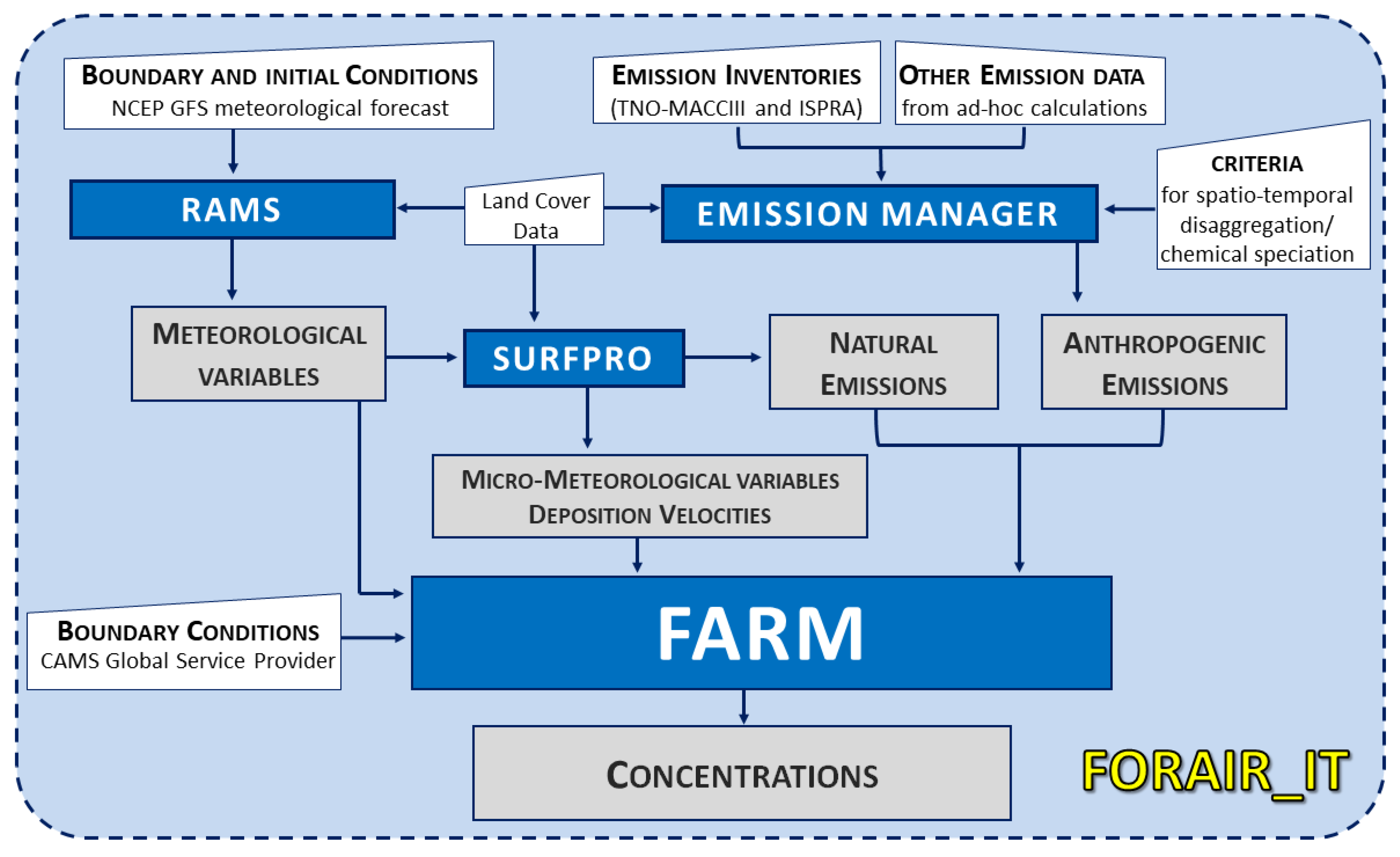
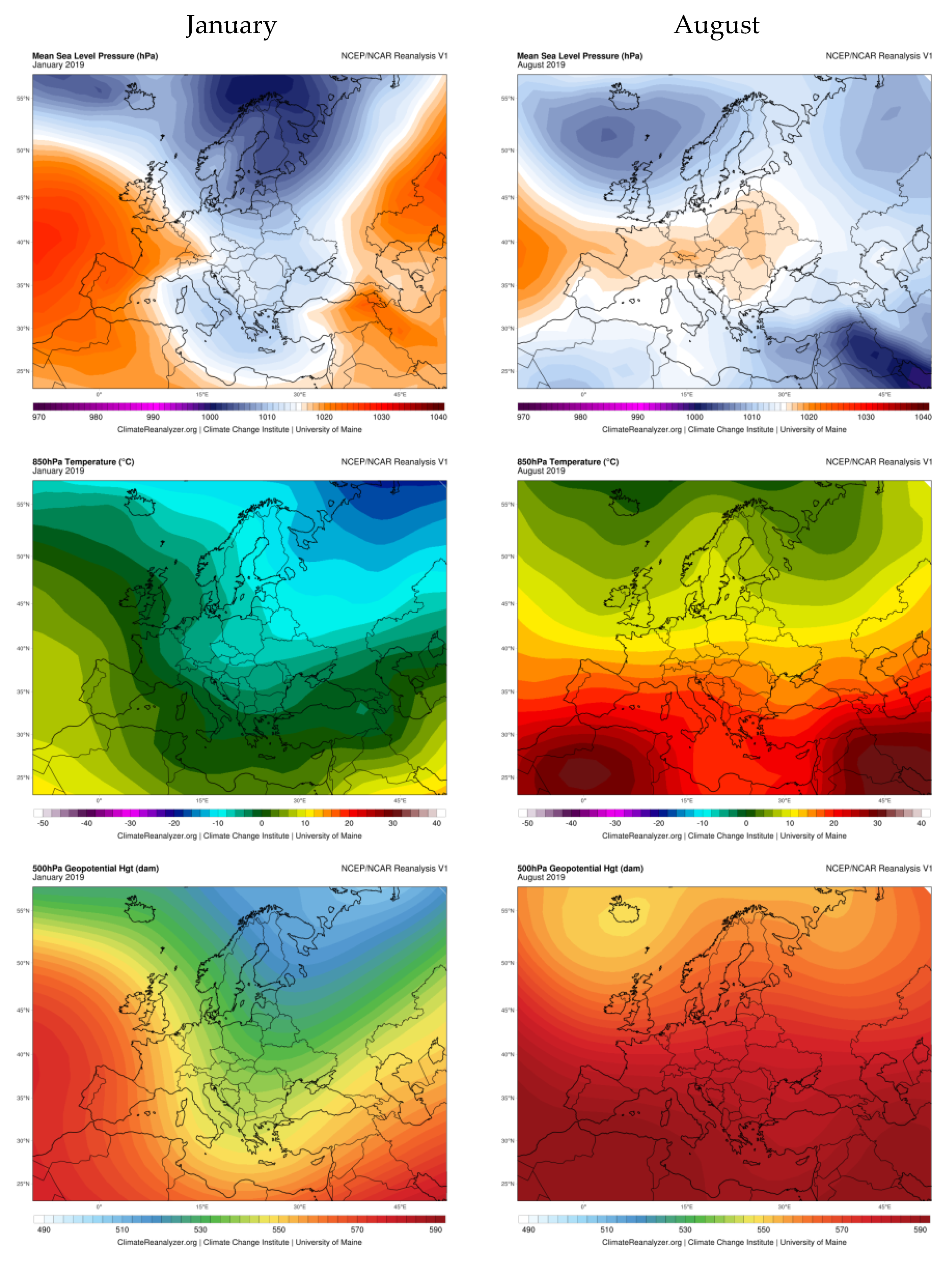
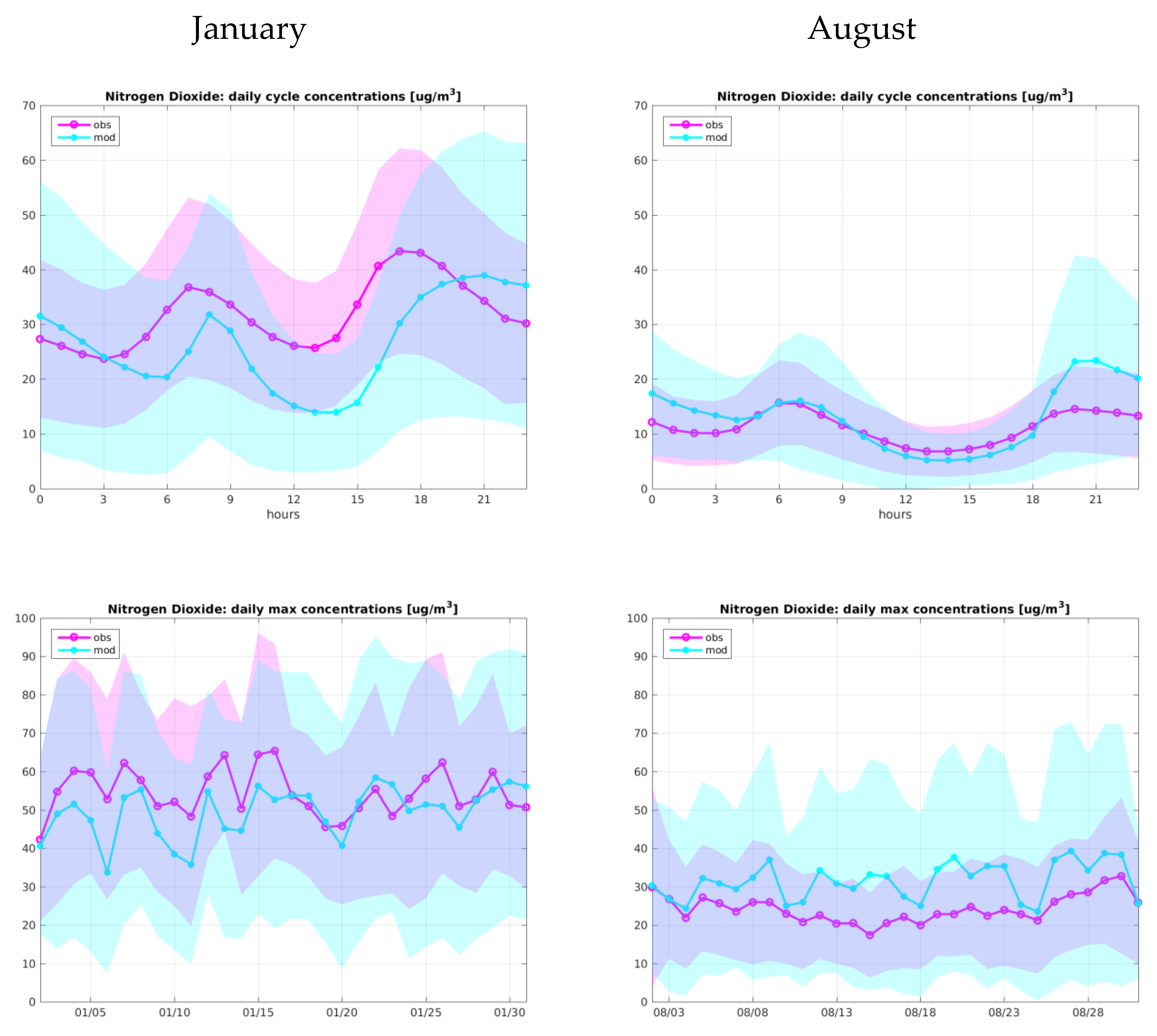
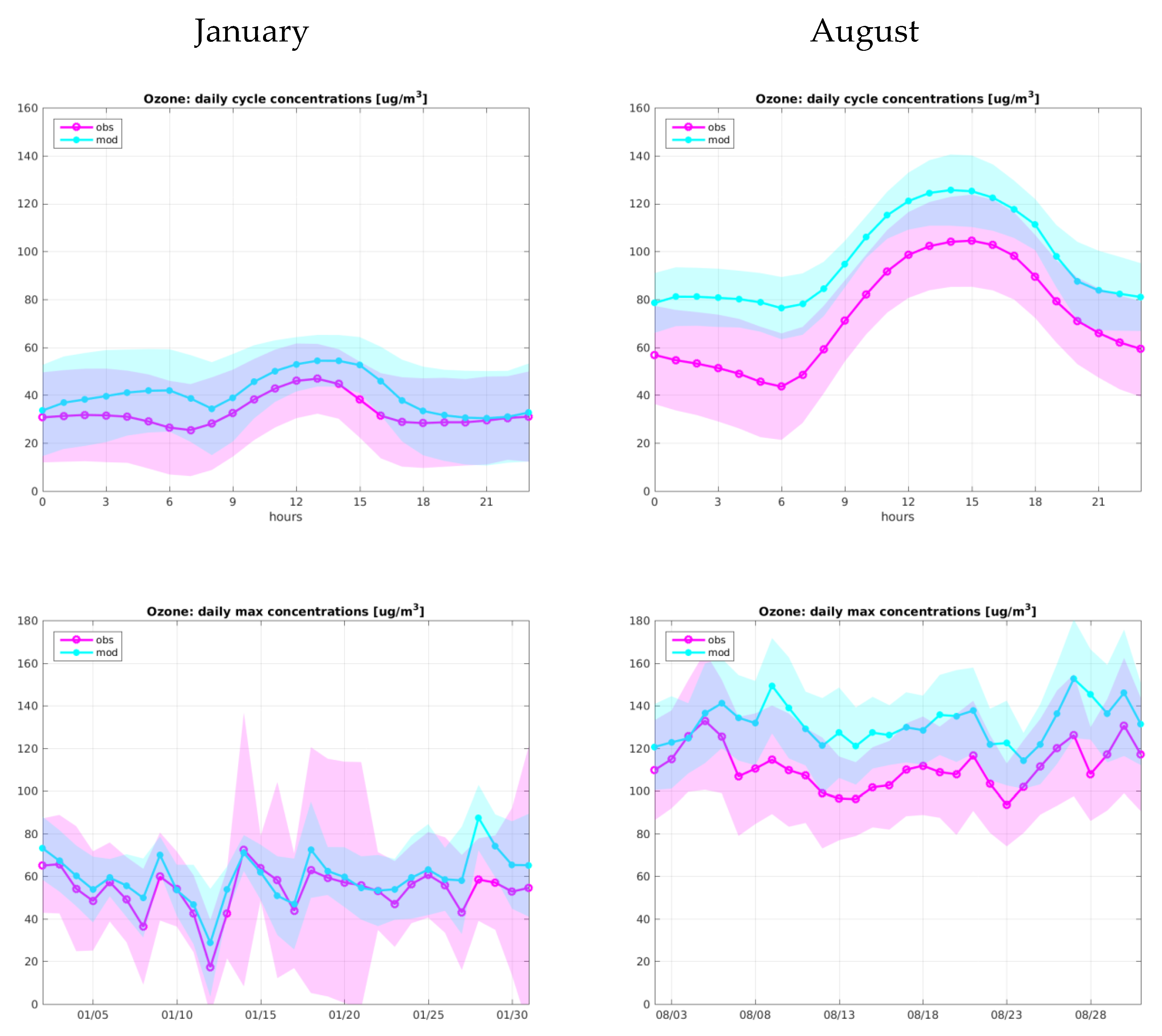

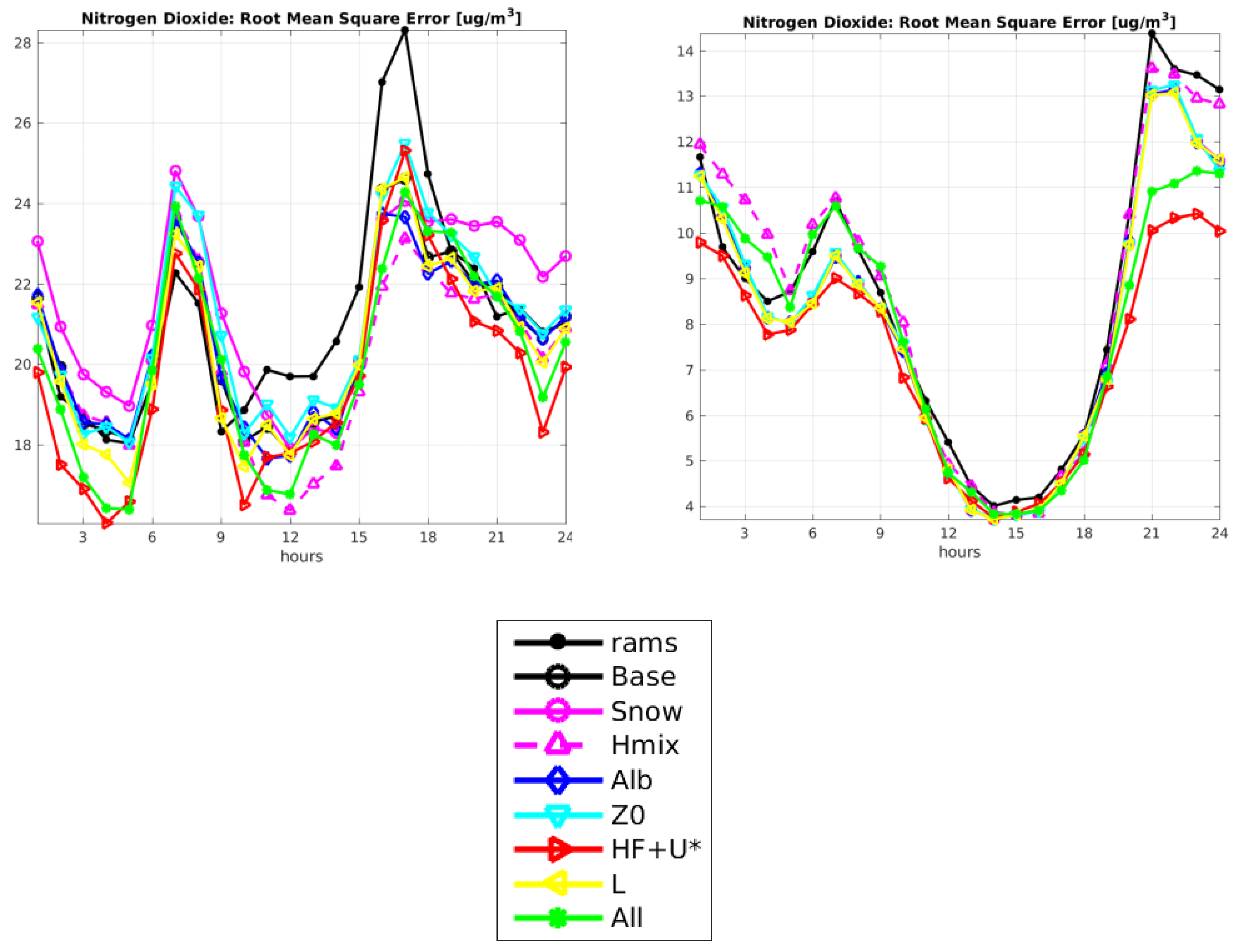
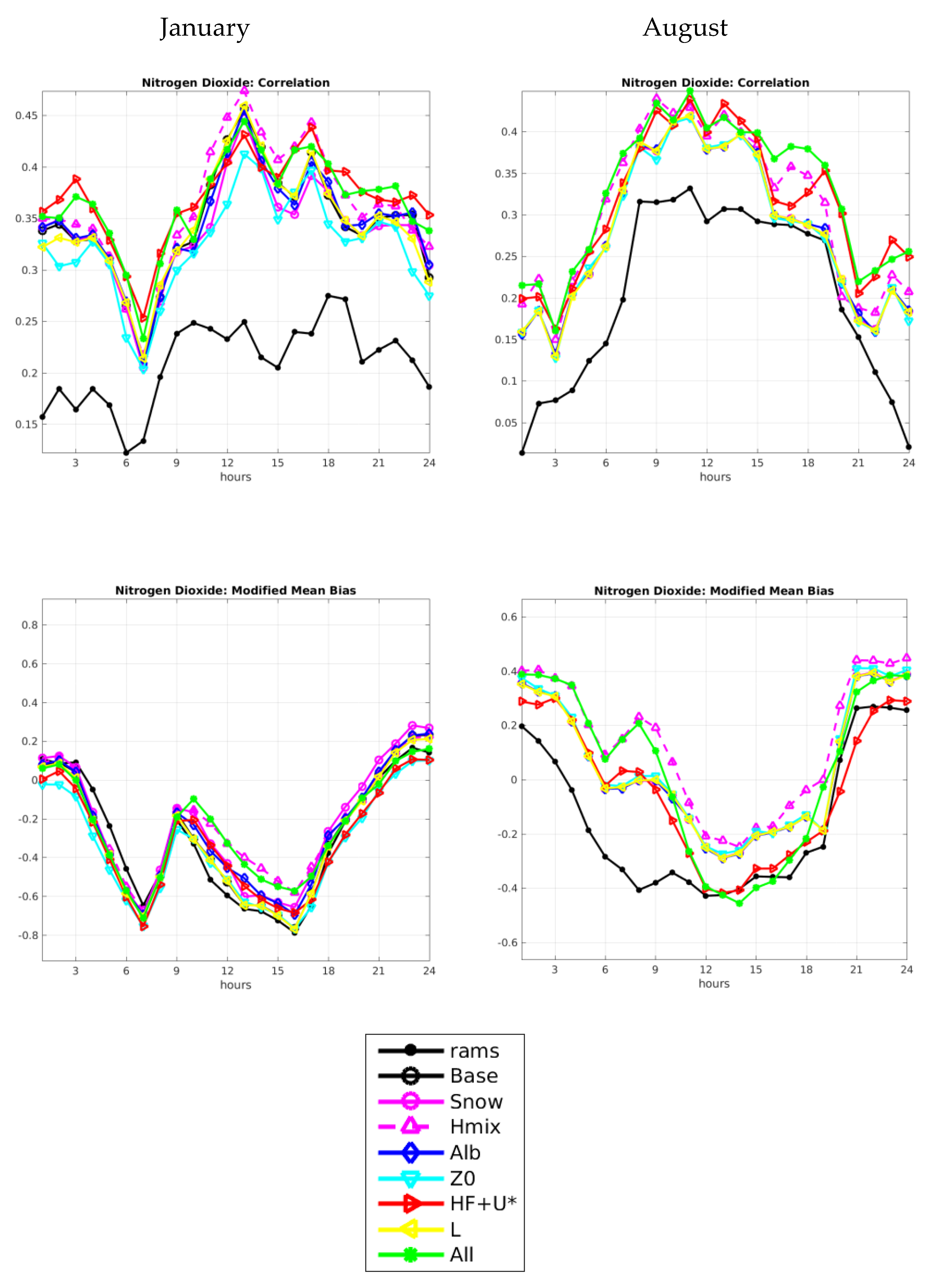
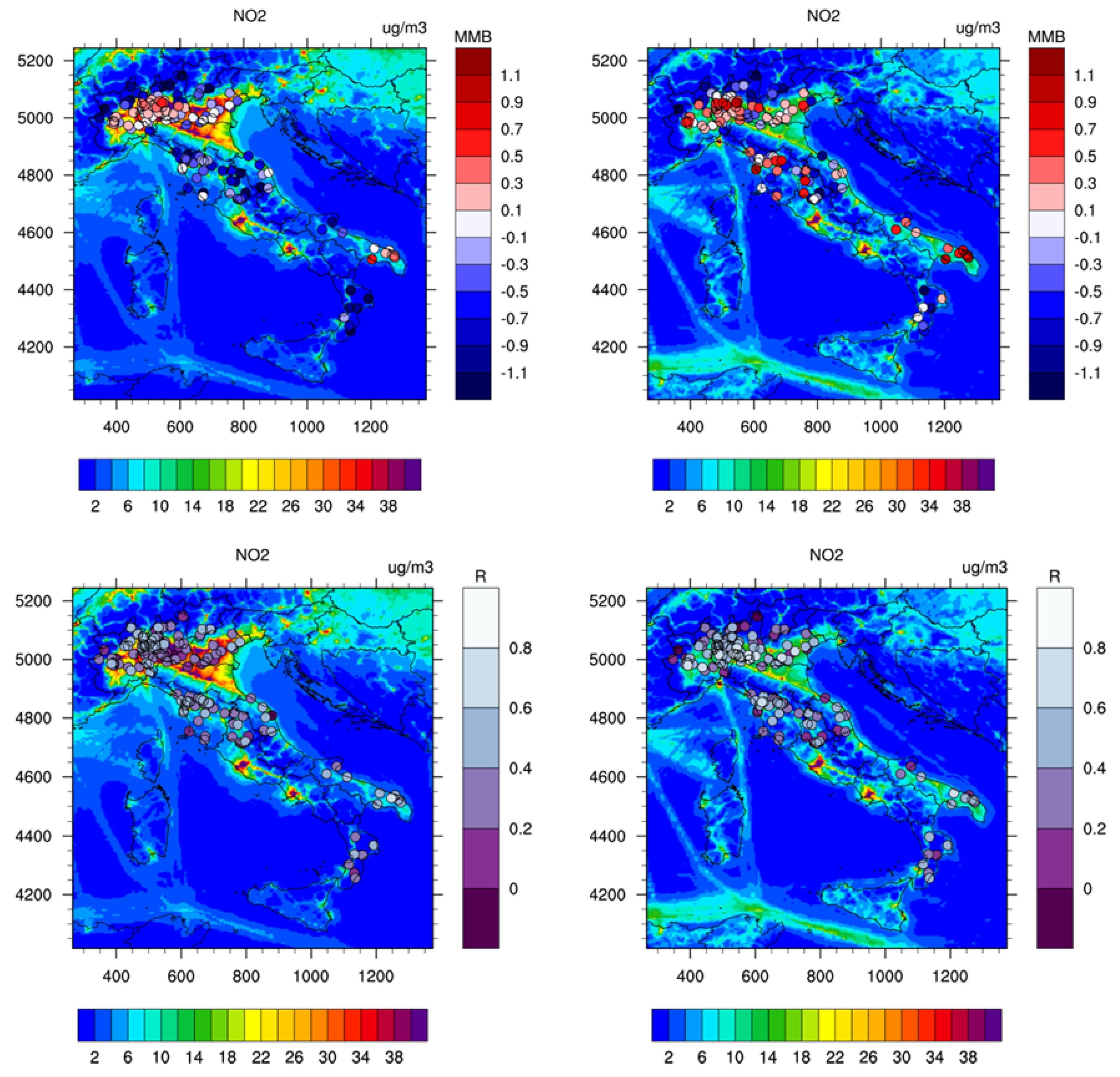
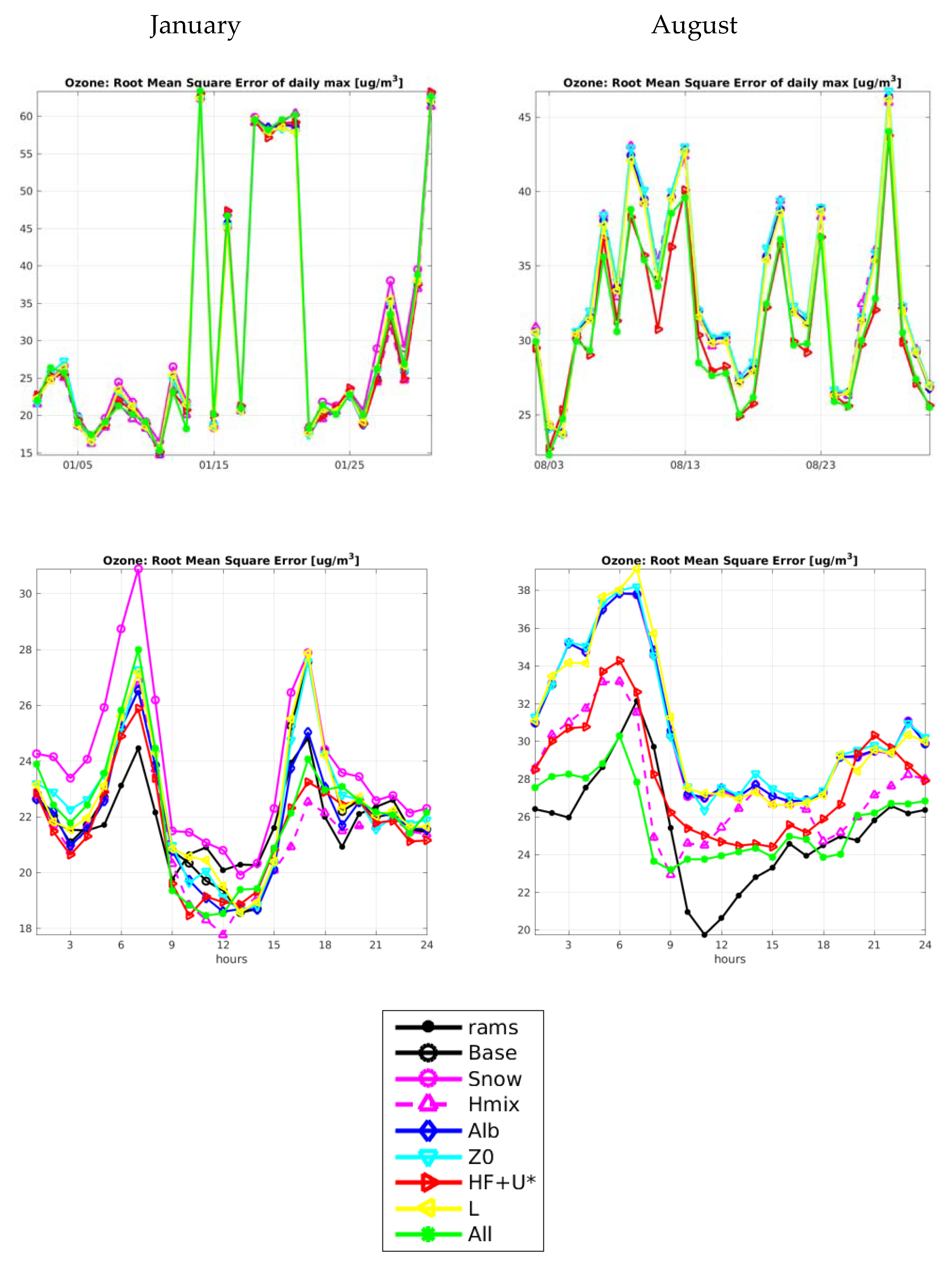
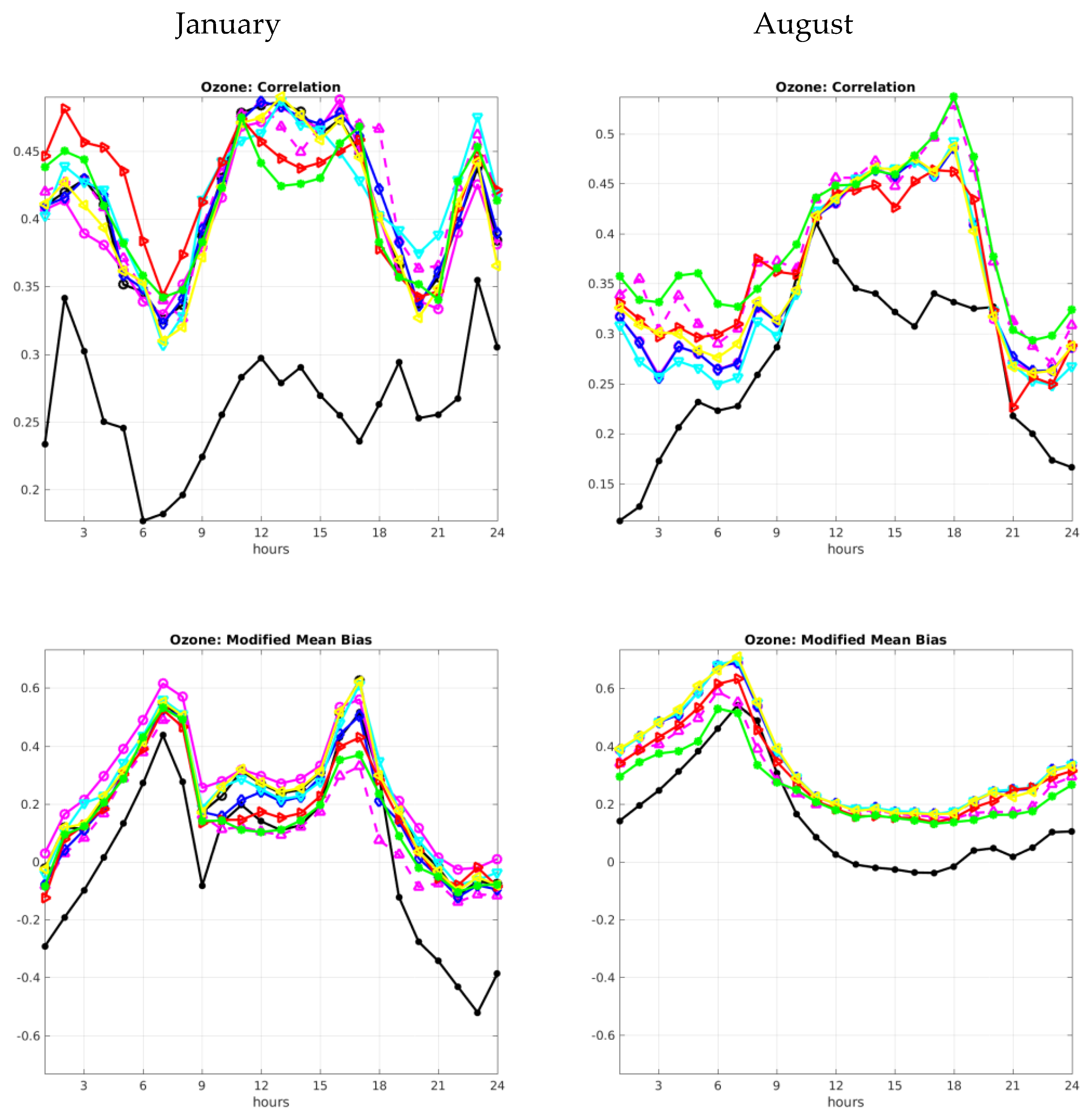
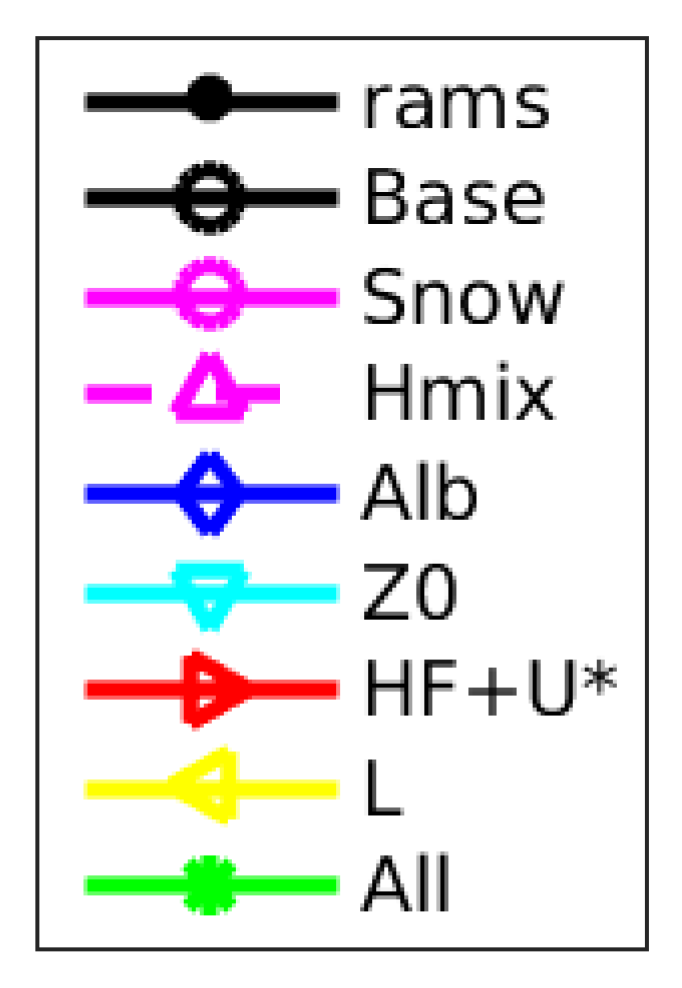
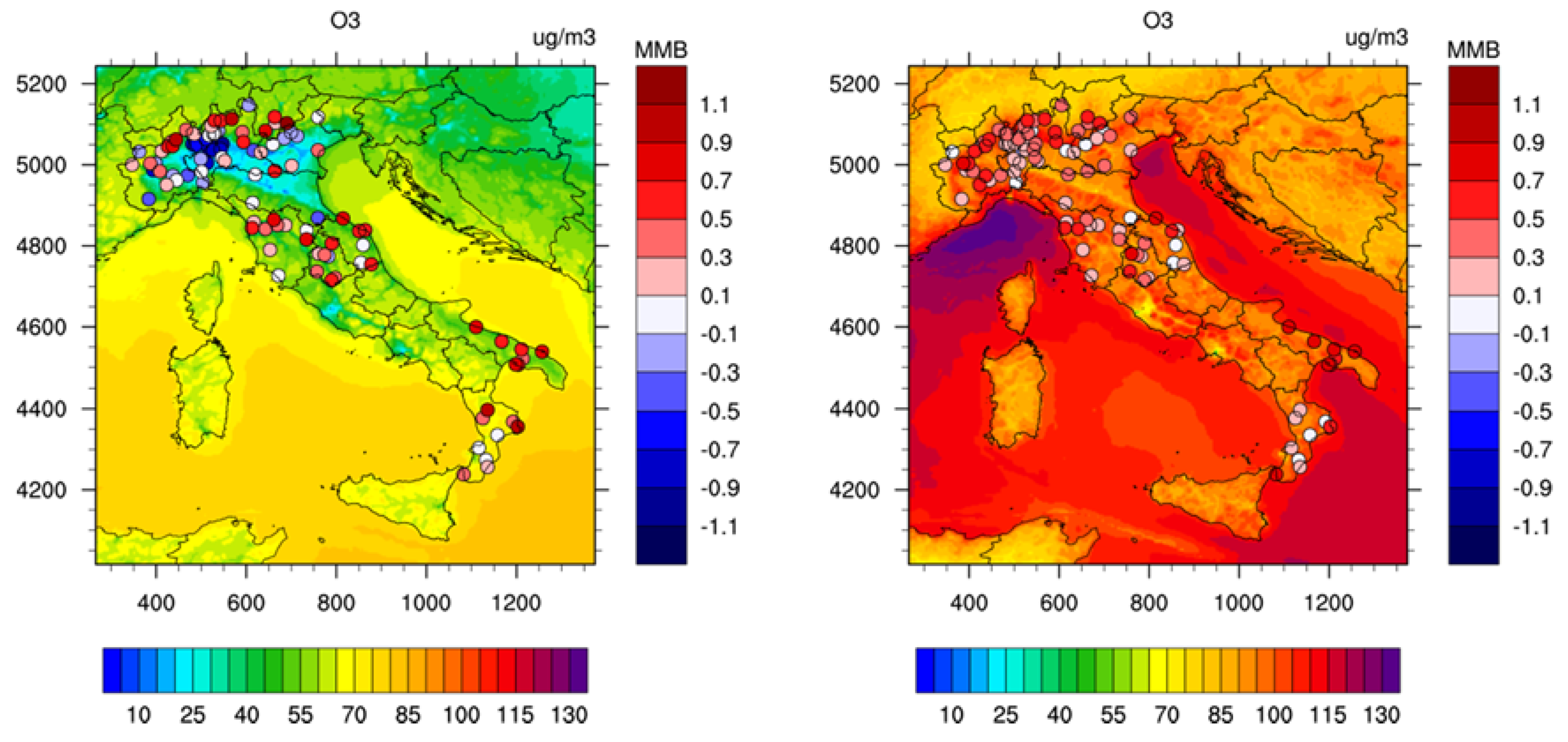
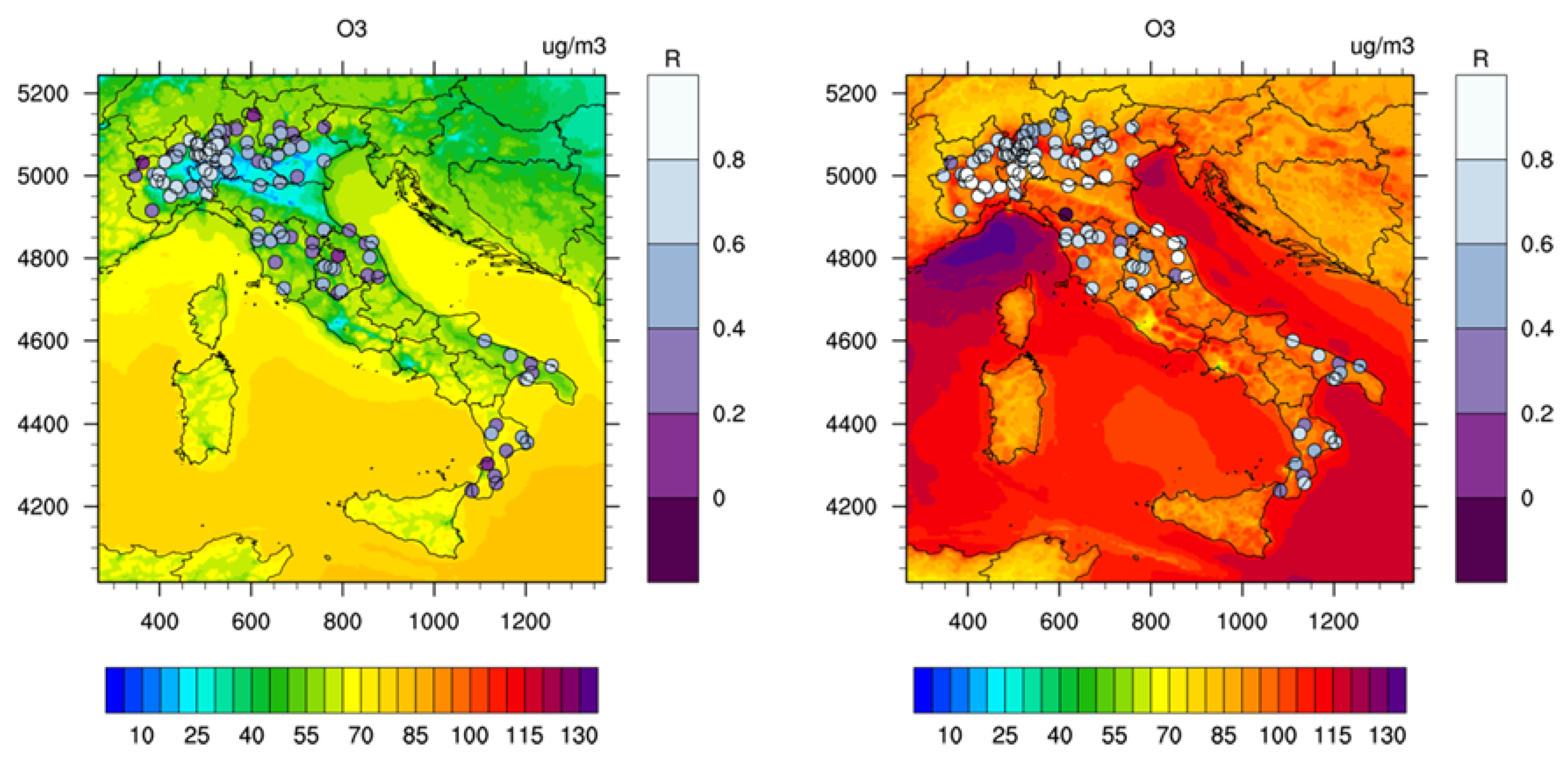
| Name | NO2 | O3 |
|---|---|---|
| Urban | 73 | 47 |
| Suburban | 36 | 28 |
| Rural | 27 | 27 |
| Name | Micrometeorology |
|---|---|
| Base | S |
| Snow | S + snow |
| Hmix | S + mixing height |
| Alb | S + albedo |
| Z0 | S + roughness length |
| HF+U* | S + heat flux + friction velocity |
| All | S + Snow + Hmix + Alb + Z0 + HF+U* + L |
| RAMS | S |
| January | August | |||||
|---|---|---|---|---|---|---|
| RMSE | R | MMB | RMSE | R | MMB | |
| Base | 23.5 | 0.56 | −0.35 | 13.7 | 0.42 | −0.02 |
| Snow | 24.7 | 0.56 | −0.29 | 13.7 | 0.42 | −0.02 |
| Hmix | 23.4 | 0.57 | −0.29 | 15.3 | 0.45 | 0.07 |
| Alb | 23.4 | 0.56 | −0.29 | 13.7 | 0.42 | −0.02 |
| Z0 | 23.4 | 0.55 | −0.33 | 13.8 | 0.42 | −0.02 |
| HF+U* | 22.3 | 0.57 | −0.4 | 12.2 | 0.45 | −0.08 |
| L | 23.1 | 0.56 | −0.35 | 13.7 | 0.41 | −0.02 |
| All | 23.4 | 0.57 | −0.30 | 13.7 | 0.47 | −0.02 |
| RAMS | 22.8 | 0.48 | −0.30 | 13.3 | 0.36 | −0.2 |
| January | August | |||||
|---|---|---|---|---|---|---|
| RMSE | R | MMB | RMSE | R | MMB | |
| Base | 31.1 | 0.45 | 0.14 | 35.4 | 0.64 | 0.35 |
| Snow | 32.5 | 0.44 | 0.18 | 35.4 | 0.64 | 0.35 |
| Hmix | 30.5 | 0.45 | 0.05 | 33.1 | 0.65 | 0.30 |
| Alb | 31.0 | 0.45 | 0.11 | 35.4 | 0.64 | 0.35 |
| Z0 | 31.2 | 0.45 | 0.17 | 35.7 | 0.64 | 0.35 |
| HF+U* | 30.7 | 0.44 | 0.11 | 33.5 | 0.65 | 0.32 |
| L | 31.4 | 0.45 | 0.14 | 35.6 | 0.63 | 0.34 |
| All | 31.1 | 0.43 | 0.08 | 31.5 | 0.67 | 0.28 |
| RAMS | 30.1 | 0.38 | 0.01 | 29.6 | 0.54 | 0.18 |
© 2020 by the authors. Licensee MDPI, Basel, Switzerland. This article is an open access article distributed under the terms and conditions of the Creative Commons Attribution (CC BY) license (http://creativecommons.org/licenses/by/4.0/).
Share and Cite
Adani, M.; Piersanti, A.; Ciancarella, L.; D’Isidoro, M.; Villani, M.G.; Vitali, L. Preliminary Tests on the Sensitivity of the FORAIR_IT Air Quality Forecasting System to Different Meteorological Drivers. Atmosphere 2020, 11, 574. https://doi.org/10.3390/atmos11060574
Adani M, Piersanti A, Ciancarella L, D’Isidoro M, Villani MG, Vitali L. Preliminary Tests on the Sensitivity of the FORAIR_IT Air Quality Forecasting System to Different Meteorological Drivers. Atmosphere. 2020; 11(6):574. https://doi.org/10.3390/atmos11060574
Chicago/Turabian StyleAdani, Mario, Antonio Piersanti, Luisella Ciancarella, Massimo D’Isidoro, Maria Gabriella Villani, and Lina Vitali. 2020. "Preliminary Tests on the Sensitivity of the FORAIR_IT Air Quality Forecasting System to Different Meteorological Drivers" Atmosphere 11, no. 6: 574. https://doi.org/10.3390/atmos11060574
APA StyleAdani, M., Piersanti, A., Ciancarella, L., D’Isidoro, M., Villani, M. G., & Vitali, L. (2020). Preliminary Tests on the Sensitivity of the FORAIR_IT Air Quality Forecasting System to Different Meteorological Drivers. Atmosphere, 11(6), 574. https://doi.org/10.3390/atmos11060574






